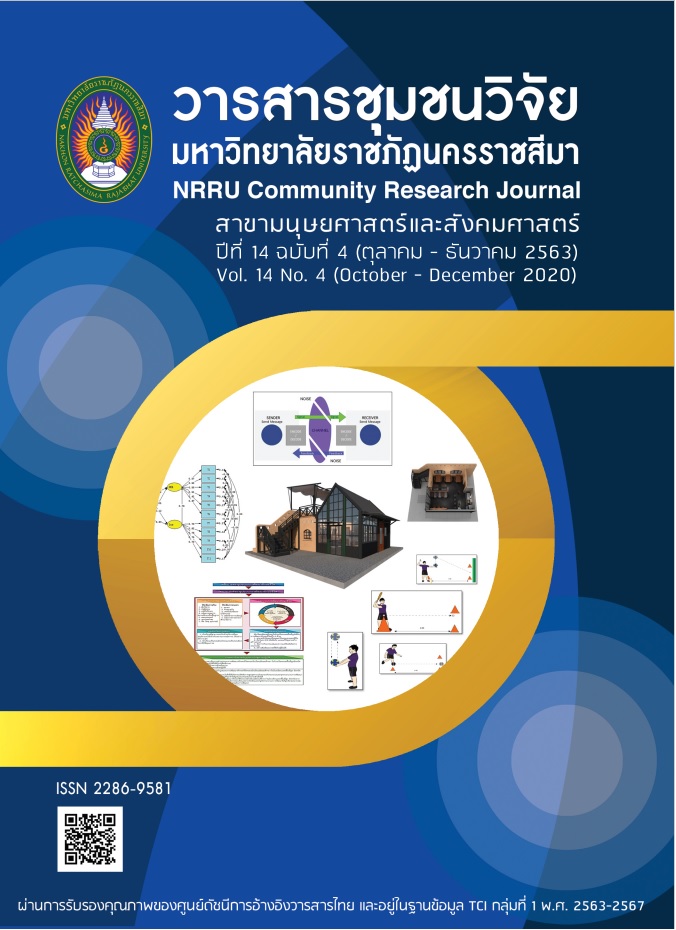PRESENTATION OF QUALITATIVE RESEARCH FINDINGS
DOI:
https://doi.org/10.14456/nrru-rdi.2020.61Keywords:
Qualitative research, Research design, Findings presentationAbstract
Presenting of research project’s findings is particularly significant for researchers as it can answer the questions and objectives of every research project that all stakeholder prefers. Nowadays, there are many types of research methodologies, including qualitative research, quantitative research, and mixed-method research. Each of these has different strategies, design, data collection and analysis, and patterns of presenting the finding. Qualitative research focuses on finding truth from events and real-life environments and trying to analyze the relationship between events and environments in order to gain in-depth understanding. Most qualitative research is the search for truth in the naturalistic inquiry. This fact is not only factual data, but also includes wealth of interesting information surrounding the phenomena. The essential part of qualitative research is therefore based on presenting findings that can answer research questions. Researchers must have thoroughly understanding of their research paradigm from beginning to end and describe all the continuously details to the readers for their fully and accurately understanding. This paper consequently presents distinctive approaches of presenting the finding of qualitative research which different from quantitative and mix-method research. This is to provide more alternative approaches for researchers in choosing appropriate presentation strategies of the findings of their qualitative projects.
References
Andrews, M., Squire, C., & Tamboukou. (2013). Doing narrative research. Los Angeles, CA : Sage Publication.
Athens, L. (2010). Naturalistic Inquiry in Theory and Practice. Journal of Contemporary Ethnography, 39(1), 87-125.
Babbie, E. (2008). The Basics of Social Research (4th ed.). Belmont, CA : Thomson Wadsworth.
Barley, S. R. (2016). 60th anniversary essay: Ruminations on how we became a mystery house and how we might get out. Adminstrative Sciences Quarterly, 61(1), 1-8.
Bryman, A. (1988). Quantity and Quality of Social Research. London : Routledge.
Creswell, J. W. (2009). Research Design: Qualitative, Quantitative, and Mixed Methods Approaches (3rd ed.). Los Angeles : SAGE.
Creswell, J. W. (2013). Qualitative Inquiry & Research Design: Choosing Among Five Approaches (3rd ed.). Thousand Oaks, California : SAGE.
Creswell, J. W., & Plano Clark, V. L. (2018). Designing and Conducting Mixed Methods Research (3rd ed.). Los Angeles : SAGE Publications, Inc.
Gehman, J., Trevino, L., & Garud, R. (2013). Values Work: A Process Study of the Emergence and Performance of Organizational Values Practices. Academy of Management Journal, 56(1), 84-112.
Gioia, D. A., Corley, K. G., & Hamilton, A. L. (2012). Seeking Qualitative Rigor in Inductive Research: Notes on the Gioia Methodology. Organizational Research Methods, 16(1), 1-31.
Gourlay, A., Mshana, G., Birdthistle, I., Bulugu, G., Zaba, B., & Urassa, M. (2014). Using vignettes in qulaitative research to explore barriers and facilitating factors to the uptake of prevention of mother-to-child transmission services in rural Tanzania: a critical analysis. BMC Medical Research Methodology, 14(21), 1-11.
Hsieh, H-F., & Shannon, S. E. (2005). Three Approaches to Qualitative Content Analysis. Qualitative Health Research, 15(9), 1277-1288.
Hughes, R., & Huby, M. (2004). The Construction and interpretation of vignettes in social research. Social Work & Social Sciences Review, 11(1), 36-51.
Jarzabkowski, P. A., & Le, J. K. (2017). We have to do this and that? You must be jokinng: Constructing and responding to paradox through humor. Organization Studies, 38(3-4), 433-462.
Joungtrakul, J. (2009). Industrial Democracy and Best Practice in Thailand. Saarbrucken, Germany: LAP Lambert Academic Publishing AG & Co. KG. (In Thai)
Joungtrakul, J. (2010). Qualitative Research: A Tool for Knowledge Creation for National Development. Bangkok : Business Law Center International Company Limited. (In Thai)
Joungtrakul, J. (2017). Research Design in Practice:: A Study from Research Articles in Acacemic Journal in Thailand. Praewar Kalasin Academic Journal, 4(2), 172-206. (In Thai)
Joungtrakul, J. (2020). Research Design: Ethical and Trustworthiness Issues in Qualitative Research. Bangkok : Business Law Center International Company Limited. (In Thai)
Joungtrakul, J. & Wongprasith, N. (2019). Content Analysis in Qualitative Research. PAAT Journal, 2(2), 1-14. (In Thai)
Kandemir, A., & Budd, R. (2018). Using Vignettes to Explore Reality and Values With Young People. Social Research, 19(2). Retrieved Septermber 13, 2020, from https://www.qualitative-research.net/index.php/fqs/article/download/2914/4194
Kothari, C. R. (2004). Research Methodology: Methods and Techniques (2nd ed.). New Delhi : New Age International (P) Limited, Publishers.
Lieblich, A., Tuval-Mashiach, R., & Zilber, T. (1998). Narative Research: reading, analysis, and interpretation. Thousand Oaks : Sage Publications.
Lok, J., & De Ron, M. (2013). On the plasticity of institutions: Containing and restoring practice breakdowns at the Cambridge University Boat Club. Academy of Management Journal, 56(1), 185-207.
Merriam, S. B. (1988). Case Study Research in Education: A Qualitative Approach. San Francisco: Jossey-Bass.
Reay, T., Zafar, A., Monteiro, P., & Glaser, V. (2019). Presenting Findings from Qualitative Research: One Size Does Not Fit All!. Research in the Sociology of Organizations, 2019, 201-216.
Research Strategies. (n.d.).EDP520 Research Methods in Education. Retrieved August 29, 2020, from http://web.csulb.edu/~arezaei/EDP520/powerpoint/6%20research%20strategies%20short%20.ppt
Roja, F. (2010). Power through institutional work: Acquiring academic authority in the 1968 third world strike. Academy of Management Journal, 53(6), 1263-1280.
Sheree, B., & Clark, A. M. (2018). Improving Qualitative Reseach Findings Presentations: Insights From Genre Theory. International Journal of Qualitative Methods, 17, 1-10.
Stake, R. E. (1995). The Art of Case Study Research. Thousand Oaks : Sage.
Strauss, A., & Corbin, J. (1998). Basic of qualitative researrch: Techiques and procedures for developing grounded theory (2nd ed.). California : SAGE.
Suwan, M. (2001). Research Methodology in Social Sciences and Humanities. Bangkok : O.S. Printing House. (In Thai)
Taylor, S. J., Bogdam, R., & DeVault, M. L. (2006). Introduction to Qualitative Research Methods: a Guidebook and Source (4th ed.). USA : Wiley.
Verdinelli, S., & Scagnoli, N. (2013). Dara Display in Qualitative Research. International Journal of Qualitative Methods, 12, 359-381.
Wright, A. L., & Zammuto, R. F. (2013). Wielding the willow: Processes of institutional change in English county cricket. Academy of Management Journal, 56(1), 308-330.
Yin, R. K. (2011). Qualitative Research from Start to Finish. New York : Guilford.





